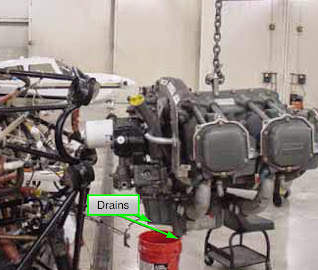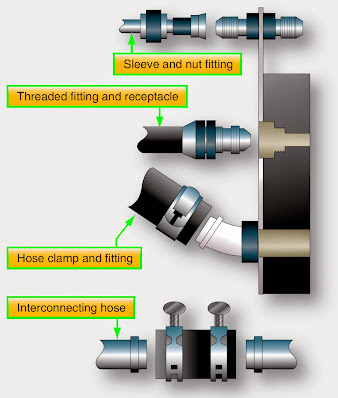Before starting to work on the aircraft or reciprocating engine, always be sure that the magneto switch is in the off position. Aircraft engines can be started accidentally by turning the propeller if the magneto switch is on.
Check to see that all fuel selectors or solenoid-operated fuel shutoff valves are closed. The fuel selector valves are either manually or solenoid operated. If solenoid-operated fuel shutoff valves are installed, it may be necessary to turn the battery switch on before the valves can be closed, since the solenoid depends on electricity for operation. These valves close the fuel line at the firewall between the engine and the aircraft. After ensuring that all fuel to the engine is shut off, disconnect the battery to eliminate the possibility of a hot wire starting a fire. If it is anticipated that the aircraft will be out of service for more than 6 days, the battery is usually removed and taken to the battery shop and placed on charge.
Also, a few other preparations should be made before starting to work on the engine removal. First, make sure that there are enough fire extinguishers near at hand to meet any possible emergency. Check the seals on these extinguishers to be sure the extinguishers have not been discharged. Then, check the wheel chocks. If these are not in place, the aircraft can, and probably will, inch forward or back during some crucial operation. Also, if the aircraft has a tricycle landing gear, be sure that the tail is supported so that the aircraft cannot tip back when the weight of the engine is removed from the forward end. It is not necessary to support the tail on some multiengine aircraft if only one engine is to be removed. In addition, the landing gear shock struts can be deflated to prevent them from extending as the engine weight is removed from the aircraft.
After taking these necessary precautions, begin removing the cowling from around the engine. As it is removed, clean it and check for cracks so that the necessary repairs can be made while the engine change is in progress. Place all cowling that does not need repair on a rack where it can be readily found when the time comes to reinstall it on the new engine. After removing the cowling, the propeller should be removed for inspection or repair.
Draining the Engine
Place a large metal pan (drip pan) on the floor under the engine to catch any spilled mixture or oil. Next, secure a clean container in which to drain the oil or corrosion-preventive mixture. Place the container beneath the engine, open the drain valve, and allow the oil to drain. Figure 1 shows the points at which a typical aircraft engine oil system is drained. Other points at which the oil system is drained can typically include the oil cooler, oil return line, and engine sumps. All valves, drains, and lines must remain open until the oil system has been completely drained. After draining the oil, reinstall all drain plugs and close all drain valves. Then, wipe all excess oil from around the drain points.
Electrical Disconnects
Electrical disconnections are usually made at the engine firewall. When the basic engine is being removed, the electrical leads to such accessories as the starter and generators are disconnected at the units themselves. When disconnecting electrical leads, it is a good safety habit to disconnect the magnetos first and immediately ground them at some point on the engine or the assembly being removed. Most firewall disconnections of electrical conduit and cable are simplified by use of (Army/Navy) AN or (Military Standard) MS connectors. Each connector consists of two parts: a plug assembly and a receptacle assembly. To prevent accidental disconnection during airplane operation, the outlet is threaded to permit a knurled sleeve nut to be screwed to the outlet and then fastened with safety wire, if necessary.
A typical plug fitting assembly is shown in Figure 2. It also shows a typical junction box assembly, which is used as a disconnect on some aircraft engine installations. After the safety wire is broken, remove all of it from the sleeve nuts that hold the conduit to the junction boxes, as well as from the nuts on the connectors. Wrap moisture proof tape over the exposed ends of connectors to protect them from dirt and moisture. Also, do not leave long electrical cables or conduits hanging loose, since they may become entangled with some part of the aircraft while the engine is being hoisted. It is a good practice to coil all lengths of cable or flexible conduit neatly, and tie or tape them to some portion of the assembly being removed.
Disconnection of Engine Controls
The engine control rods and cables connect such units as the carburetor or fuel control throttle valve and the mixture control valve with their manually actuated control in the cockpit. The controls are sometimes disconnected by removing the turnbuckle that joins the cable ends. [Figure 3] A typical reciprocating engine control linkage consisting of a control rod attached to a bell crank is illustrated in Figure 4.
The control rod in the linkage shown has two rod-end assemblies, a clevis, and an eye screwed onto opposite ends. These rod-end assemblies determine the length of the control rod by the distance they are screwed onto it, and they are locked into position by cheek nuts. An antifriction bearing is usually mounted in the eye end of a rod. This eye is slipped over a bolt in the bell crank arm and is held in position by a castle nut safety with a cotter pin. The clevis rod end is slipped over the end of a bell crank arm, which also usually contains an antifriction bearing. A bolt is passed through the clevis and the bell crank eye, fastened with a castle nut, and safetied with a cotter pin.
Sometimes linkage assemblies do not include the antifriction bearings and are held in position only by a washer and cotter pin in the end of a clevis pin that passes through the bell crank and rod end. After the engine control linkages have been disconnected, the nuts and bolts should be replaced in the rod ends or bell crank arms to prevent their being lost. All control rods should be removed completely or tied back to prevent them from being bent or broken if they are struck by the replacement engine or QECA as it is being hoisted.
Disconnection of Lines
The lines between units within the aircraft and the engine are either flexible hose or aluminum-alloy tubes joined by lengths of hose clamped to them. Lines that must withstand high pressure, such as hydraulic lines, are often made of stainless steel tubing.
Figure 5 shows the basic types of line disconnects. Most lines leading from a QECA are secured to a threaded fitting at the firewall by a sleeve nut around the tubing. Hoses are sometimes secured in this manner but may also be secured by a threaded fitting on the unit to which they lead, or by a hose clamp. The firewall fittings for some lines have a quick-disconnect fitting that contains a check valve to prevent the system from losing fluid when the line is disconnected. Metal tubing on some installations may also be disconnected at a point at which two lengths of it are joined together by a length of rubber hose. Such a disconnection is made by loosening the hose clamps and sliding the length of rubber hose over the length of tubing that remains on the aircraft. There may be some further variations in these types of disconnections, but they follow the same basic pattern.
Some type of a container should be used to collect any fuel, oil, or other fluid that may drain from the disconnected lines. After the lines have drained, they should be immediately plugged or covered with moisture-proof tape to prevent foreign matter from entering them, as well as to prevent any accumulated fluid from dripping out.
Other Disconnections
The points at which the various air ducts are disconnected depend upon the engine and the aircraft in which it is installed. Usually, the air intake ducts and the exhaust system must be disconnected so the basic engine or the QECA can be removed. After the engine connections are free (except the engine mounts) and all the disconnections are entirely clear so they do not bind or become entangled, the engine can be prepared for hoisting.





